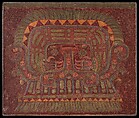Wall Painting
Not on view
The work is a portion of a frescolike wall painting from an apartment compound in the ancient Mexican city of Teotihuacan. In the first millennium A.D., residents of Teotihuacan lived in large apartment compounds, many of which were extensively decorated with wall paintings. The current example is probably one of at least eight similar images that once formed the decoration of an interior room in the compound known as Techinantitla from the east side of the city.
The fragment shows a highly abstract depiction of what may be a deity, or perhaps even an elaborate, undeciphered hieroglyphic logogram (a sign representing a word). The symmetry of the figure and the location of a toothed mouth and clawed hands suggest a stylized anthropomorphic being. From the mouth emerges scrolls covered in images of flowers, perhaps a visual representation of "flowery speech" or benevolent oration. The figure is covered in circular and ovular shapes painted green—mostly likely images of jade beads—and fringed with green feathers; both greenstone and green feathers were luxurious imported materials. The green color evokes water, maize plants, and agricultural fertility.
A similar fragment is in the collections of the Sainsbury Centre for the Visual Arts, and a fragment of the same mural series in the Ethnological Museum in Berlin includes a border that repeats the jade and feathered motifs. Not all aspects of the mural's central character are flowery and green, however: the fearsome claws at the center of the image hint at the threat of potential violence by natural forces, divine power, or Teotihuacan’s own military regime.
Further reading
Berrin, Kathleen, and Esther Pasztory. Teotihuacan: Art from the City of the Gods. The Fine Arts Museums of San Francisco, 1993.
Carballo, David M., Kenneth G. Hirth, and Barbara Arroyo. Teotihuacan: The World Beyond the City. Dumbarton Oaks, 2020.
Cowgill, George L. State and Society at Teotihuacan. Annual Review of Anthropology, Vol. 26, pp. 129-161, 1997.
Evans, Susan Toby, "Teotihuacan Murals: An Appendix," in Processions in the Ancient Americas, Penn State University Occasional Papers in Anthropology No. 33 (2016): 122–153
Galitz, Kathryn. The Metropolitan Museum of Art: Masterpiece Paintings. New York: Skira, 2016, no. 44.
Headrick, Annabeth. The Teotihuacan Trinity: The Sociopolitical Structure of an Ancient Mesoamerican City. University of Texas Press, 2007.
Manzanilla, Linda R. Cooperation and tensions in multiethnic corporate societies using Teotihuacan, Central Mexico, as a case study. Proceedings of the National Academy of Sciences of the United States of America Vol. 112, No. 30, pp. 9210-9215, 2015.
Murakami, Tatsuya. Entangled Political Strategies: Rulership, Bureaucracy, and Intermediate Elites at Teotihuacan. In Sarah Kurnick and Joanne Baron, eds., Political Strategies in Pre-Columbian Mesoamerica, pp. 153-179. University Press of Colorado, 2016.
Pasztory, Esther. Teotihuacan: An Experiment in Living. University of Oklahoma Press, 1997.
"Recent Acquisitions: A Selection 2014." In Metropolitan Museum of Art Bulletin. Vol. vol. 72, no.2. Fall 2014, p. 15.
Robb, Matthew, ed. Teotihuacan: City of Water, City of Fire. San Francisco: de Young Museum, Fine Arts Museums of San Francisco, 2017, no. 180, p. 410.
Ruiz Gallut, María Elena, and Jesús Torres Peralta, eds. Arquitectura y urbanismo: pasado y presente de los espacios en Teotihuacan: Memoria de la Tercera Mesa Redonda de Teotihuacan. Mexico City, Instituto Nacional de Antropología e Historia, 2005.
Sarro, Patricia J., and Matthew H. Robb. Passing through the Center: The Architectural and Social Contexts of Teotihuacan Painting. In Cynthia Kristan-Graham and Laura M. Amrhein, eds., Memory Traces: Analyzing Sacred Space at Five Mesoamerican Sites, pp. 21-43. University Press of Colorado, 2015.
Sugiyama, Saburo. Human Sacrifice, Militarism, and Rulership: Materialization of State Ideology at the Feathered Serpent Pyramid, Teotihuacan. Cambridge University Press, 2005.
Taube, Karl A. The Temple of Quetzalcoatl and the Cult of Sacred War at Teotihuacan. RES: Anthropology and Aesthetics, No. 21, pp. 53-87, Spring, 1992.
Turner, Andrew. Unmasking Tlaloc: The Iconography, Symbolism, and Ideological Development of the Teotihuacan Rain God. In Anthropomorphic Imagery in the Mesoamerican Highlands: Gods, Ancestors and Human Beings, Brigitte Faugere and Christopher S. Beekman, eds. University Press of Colorado, 2020.
Due to rights restrictions, this image cannot be enlarged, viewed at full screen, or downloaded.


